|
|
|
Sort Order |
|
|
|
Items / Page
|
|
|
|
|
|
|
| Srl | Item |
| 1 |
ID:
002981
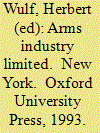

|
|
|
|
|
| Publication |
New York, Oxford University Press, 1993.
|
| Description |
xvii, 416p.
|
| Standard Number |
0198291647
|
|
|
|
|
|
|
|
|
|
|
|
Copies: C:1/I:0,R:0,Q:0
Circulation
| Accession# | Call# | Current Location | Status | Policy | Location |
| 034687 | 355.47355/WUL 034687 | Main | On Shelf | General | |
|
|
|
|
| 2 |
ID:
167298


|
|
|
|
|
| Summary/Abstract |
A better-coordinated Franco-German approach to arms exports would facilitate the development of future weapons programmes and strengthen European defence.
|
|
|
|
|
|
|
|
|
|
|
|
|
|
|
|
| 3 |
ID:
181216
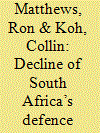

|
|
|
|
|
| Summary/Abstract |
The growth of South Africa’s apartheid era defence industry was propelled by international isolation following the 1984 UN arms embargo and revealed military technology deficiencies during the border war. Weapons innovation became an imperative, fostering development of frontier technologies and upgrades of legacy platforms that drove expansion in arms exports. However, this golden era was not to last. The 1994 election of the country’s first democratic government switched resources from military to human security. The resultant defence-industrial stagnation continues to this day, exacerbated by corruption, unethical sales, and government mismanagement. The industry’s survival into the 2020s cannot be assured.
|
|
|
|
|
|
|
|
|
|
|
|
|
|
|
|
| 4 |
ID:
129496


|
|
|
|
|
| Publication |
2014.
|
| Summary/Abstract |
This study analyzes the determinants of arms production in 15 countries using annual panel data from 1997 to 2002. The results suggest that real GDP per capita, military expenditures, arms exports, and arms imports are positively related to arms production.
|
|
|
|
|
|
|
|
|
|
|
|
|
|
|
|
| 5 |
ID:
192055


|
|
|
|
|
| Summary/Abstract |
In this paper, we study closely the relationship between arms exports, labor productivity and economic growth. Using a connectedness-measurement technology fundamentally grounded in modern network theory, we determine the size and direction of the spillover effects between these three variables. Our findings indicate that shocks from arms exports have direct spillovers over the labor productivity and GDP growth, whereas the reverse is not captured by our data. We also provide a dynamic analysis of the spillovers that confirm the direction of spillovers from arms exports to the other variables. The recent evolution of arms exports from the United States together with the changes in arms exports policy show the timeliness of studying the effects of this particular trade to the rest of the economy.
|
|
|
|
|
|
|
|
|
|
|
|
|
|
|
|
| 6 |
ID:
074372


|
|
|
|
|
| Publication |
2006.
|
| Summary/Abstract |
This article explores the impact of the EU Code of Conduct on Arms Exports on national legal frameworks, using the case studies of Belgium, Germany and Italy. It considers the differential impact of Europeanisation on high- and low-regulating countries and how non-legally binding decisions agreed in the framework of the CFSP nevertheless exert pressure on member states. It argues that the Europeanisation impact of the Code has not been insignificant, but that it has not had a uniformly strengthening impact. Rather, the Europeanisation of the Code of Conduct has promoted convergence, weakening strong national frameworks and strengthening weak ones.
|
|
|
|
|
|
|
|
|
|
|
|
|
|
|
|
| 7 |
ID:
150764
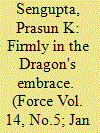

|
|
|
| 8 |
ID:
159421


|
|
|
|
|
| Summary/Abstract |
Japan's lifting of its arms export ban through the Three Principles on the Transfer of Defense Equipment and Technology has opened up new strategic opportunities for its policy-makers to reinforce existing, and build new, security partnerships. Japan still retains the intent to sustain and develop an indigenous defense production base, now through international collaboration rather than mainly autonomous production, and the leverage this may provide to hedge within and outside the US–Japan alliance framework. However, this paper demonstrates that Japan's principal objective through international arms transfers is very much to use this as a mechanism to strengthen Japan's integration of capabilities into the US–Japan alliance and overall US ‘rebalance’ strategy in East Asia. Japan's main moves in developing an arms transfer strategy have either revolved around US–Japan bilateral projects, or cooperation with US allies and partners. Moreover, Japan's continuing deficiencies in military technology and experience of international collaboration on the government and private sector levels means that its arms transfer strategy remains quite limited in ambition and especially implementation.
|
|
|
|
|
|
|
|
|
|
|
|
|
|
|
|
| 9 |
ID:
185491
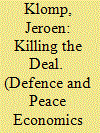

|
|
|
|
|
| Summary/Abstract |
On October 2nd, 2018, Jamal Khashoggi, a journalist and critic of the Saudi Arabian regime, disappeared after a visit to the Saudi Arabian consulate in Turkey nd was most likely murdered shortly afterwards. After this incident, a period of uncertainty started about whether or not a major arms deal that was signed between the United States and Saudi Arabia would still going to be approved by Congress or in turn will be rejected. The main findings presented in this study clearly demonstrate that the uncertainty surrounding the deal caused a significant drop in the daily return on the equity prices of US defense firms. This result suggests that investors believe that it is very likely that the major arms deal will be blocked by Congress in the short-run thereby reducing the business perspectives of the US defense-related industry. Besides these findings also imply that investors expect that the US president will not use its veto power or make permanently use of the exemption clause provided in the US arms trade legislation.
|
|
|
|
|
|
|
|
|
|
|
|
|
|
|
|
| 10 |
ID:
154921


|
|
|
|
|
| Summary/Abstract |
Why do states take the lead in diffusing norms they once resisted? I address this question in the context of new humanitarian arms trade norms, culminating in the 2013 Arms Trade Treaty (ATT). Although most major arms exporting states have supported the ATT and similar initiatives, only some have chosen to invest resources in becoming leaders of these initiatives to spread new norms beyond their borders. I examine British and German arms export policies and practices to argue that states that choose leadership following costly norm adoption may do so as a means to share the costs of those norms with other international actors and reduce future adaptation costs. By delving deeper into the agency of norm diffusion, the article offers insights into powerful states’ motivations for norm leadership following costly norm adoption, the dynamics of norm diffusion, and the institutional form international norms eventually take.
|
|
|
|
|
|
|
|
|
|
|
|
|
|
|
|
| 11 |
ID:
156228
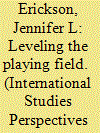

|
|
|
|
|
| Summary/Abstract |
Why do states take the lead in diffusing norms they once resisted? I address this question in the context of new humanitarian arms trade norms, culminating in the 2013 Arms Trade Treaty (ATT). Although most major arms exporting states have supported the ATT and similar initiatives, only some have chosen to invest resources in becoming leaders of these initiatives to spread new norms beyond their borders. I examine British and German arms export policies and practices to argue that states that choose leadership following costly norm adoption may do so as a means to share the costs of those norms with other international actors and reduce future adaptation costs. By delving deeper into the agency of norm diffusion, the article offers insights into powerful states’ motivations for norm leadership following costly norm adoption, the dynamics of norm diffusion, and the institutional form international norms eventually take.
|
|
|
|
|
|
|
|
|
|
|
|
|
|
|
|
| 12 |
ID:
154336


|
|
|
|
|
| Summary/Abstract |
Possession of a brand is a sine qua non for economic success, not least because it connotes trust in delivering the value promised. Although Western arms exporters offer branded systems whose sales are influenced by price, there is a plethora of other economic variables, such as offset requirements and life-cycle support. Entrants to the international arms market will struggle without such arms “packages.” China’s entry, however, goes beyond the traditional economic paradigm. A four-stage historical model offers the backdrop for identifying the drivers that have forged its market entry into 55 countries worldwide. The strategy initially focused on sales of rudimentary military equipment for political purposes, but recently it has begun to commercialize exports, repositioning them from a low- to a high-tech sales trajectory. A Sino “brand” is thus emerging, reflecting both competitiveness and diplomatic considerations, especially non-interference in client state domestic affairs.
|
|
|
|
|
|
|
|
|
|
|
|
|
|
|
|
| 13 |
ID:
170248
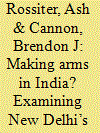

|
|
|
|
|
| Summary/Abstract |
When it comes to states arming themselves, it has become axiomatic among scholars of comparative defence industries that go-it-alone production is no longer an option for most. The processes associated with defence-industrial globalization combined with the ever-rising costs of producing leading-edge weapons systems present huge disincentives for autarky in armaments. Against these strong headwinds, however, India has recently launched, as part of a broader, multi-sector initiative called Make in India, a renewed effort to achieve greater self-reliance in armaments production. This article first places India’s recent defence indigenization efforts within wider discussions about states’ armament strategies and trends in global arms production. Secondly, it contextualizes the drivers behind New Delhi’s latest attempts to transform itself from leading arms importer to major producer (and significant exporter) against the backdrop of past efforts which have yielded little but disappointment. Third, it explicates the main facets of the current strategy for defence-industrial indigenization and gauges its chances for success. To preview the main findings, we argue that self-reliance in armaments via indigenous production will almost certainly continue to allude India because of systemic, structural and technological constraints.
|
|
|
|
|
|
|
|
|
|
|
|
|
|
|
|
| 14 |
ID:
007743


|
|
|
|
|
| Publication |
Fall 1994.
|
| Description |
16-29
|
|
|
|
|
|
|
|
|
|
|
|
|
|
|
|
| 15 |
ID:
138891
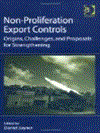

|
|
|
|
|
| Publication |
London, Ashgate, 2006.
|
| Description |
viii, 246p.Hbk
|
| Contents |
B
|
| Standard Number |
9780754644606
|
|
|
|
|
|
|
|
|
|
|
|
Copies: C:1/I:0,R:0,Q:0
Circulation
| Accession# | Call# | Current Location | Status | Policy | Location |
| 058236 | 382.456234/JOY 058236 | Main | On Shelf | General | |
|
|
|
|
| 16 |
ID:
150329


|
|
|
|
|
| Summary/Abstract |
While notifying Congress of numerous major arms sales, the Obama administration in its final months took some steps to address controversial arms trade issues by limiting certain weapons transfers to Saudi Arabia and promoting the Arms Trade Treaty.
|
|
|
|
|
|
|
|
|
|
|
|
|
|
|
|
| 17 |
ID:
095042
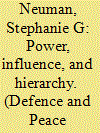

|
|
|
|
|
| Publication |
2010.
|
| Summary/Abstract |
The global defense-industrial sector reflects the hierarchy of power in the post-Cold War world. As in the larger international system, the United States plays the dominant role in the defense sector as well. It is a comparative advantage often used by US policymakers to influence the foreign policy behavior of other states. Curiously, the radical concentration of the world's defense industrial sector, as described here, has received relatively little scrutiny from either academia or the media, even though it not only reflects the international order but provides the United States with considerable leverage in it.
|
|
|
|
|
|
|
|
|
|
|
|
|
|
|
|
| 18 |
ID:
143684


|
|
|
|
|
| Summary/Abstract |
Few factors have a greater impact on the international distribution of power than states’ ability to develop and produce sophisticated weaponry. The Israeli and Swedish cases demonstrate the constraints and opportunities for small states’ defense-industrial bases in a globalizing world. The changing nature of arms production—including mounting weapons costs, globalized supply chains and the rise of multinational defense corporations—forced governments to reevaluate their defense-industrial policies. In each case, governments abandoned the pursuit of defense-industrial self-sufficiency and adopted export-dependent defenseindustrial policies. National strategies differ, however, with Sweden embracing foreign direct investment (FDI) to support incremental innovation and Israel encouraging companies to tap venture capital in pursuit of disruptive innovations. After a decade of sustained growth, the Israeli and Swedish defense-industrial bases today arguably suffer from structural weaknesses rooted in the adaptation policies each state adopted in prior decades and, more particularly, how each encouraged exports and drew on new forms of investment capital.
|
|
|
|
|
|
|
|
|
|
|
|
|
|
|
|
| 19 |
ID:
140690


|
|
|
|
|
| Summary/Abstract |
In this article, I provide an overview of the major security and defense changes achieved by the second Abe Shinzo cabinet and analyze why Abe was reasonably successful. Based on analysis of the major Japanese strategic guidelines, the new National Security Council, and legal arguments on interpretations of the constitution, I argue that Abe’s security and defense reforms are not unique to his ideology or political stance but follow the general trend Japan has pursued in the last two decades. What is unique about Abe is his drive and political tact to ram through these reforms. These reforms are also suited to shift Japan’s geopolitical focus away from the Asian continent and toward the Eurasian littoral and maritime areas, where Japan sees more economic and political opportunities without the historical controversies it faces in East Asia. KEYWORDS: Abe Shinzo, Japan’s constitution, collective self-defense, US-Japan defense relations.
|
|
|
|
|
|
|
|
|
|
|
|
|
|
|
|
| 20 |
ID:
192614
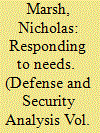

|
|
|
|
|
| Summary/Abstract |
The article analyses the provision of military aid to Ukraine during the first year after the 2022 Russian invasion and explains why it was more effective compared to other examples. It discusses the impact of material and intangible military assistance. The article examines tensions arising from principal-agent relationships between Ukraine and the states that provided support that may have affected what was provided and when it was delivered. It is notable that providers of assistance emphasised equipment rather than training, a choice that could be made because Ukraine had already built up a high level of combat skills and military organisation. The article argues that the distinctive aspects of military assistance to Ukraine that led to its impact were the quality and quantity of equipment provided, good communication and co-ordination between Ukraine and those states providing assistance, and that Ukrainian defence and government institutions could manage the aid provided.
|
|
|
|
|
|
|
|
|
|
|
|
|
|
|
|
|
|
|
|
|